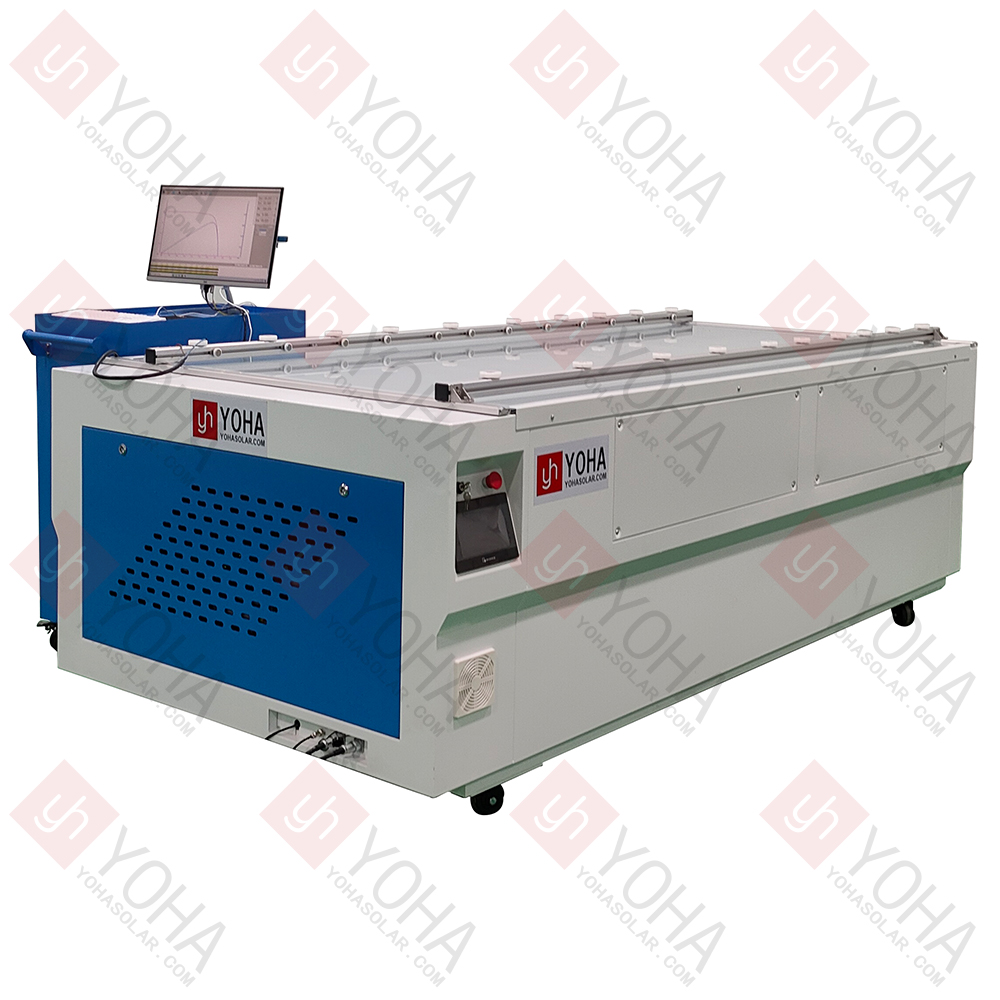Welcome to Wuhan Yoha Solar Technology Co., Ltd!
common problem
Site Map
Language:
 Chinese
Chinese
 English
English
Welcome to Wuhan Yoha Solar Technology Co., Ltd!
common problem
Site Map
Language:
 Chinese
Chinese
 English
English
A Solar Module IV Tester is a critical professional inspection device that evaluates the power output capability, detects potential defects, performs quality grading, and verifies product specification compliance. It achieves this by simulating solar irradiation under Standard Test Conditions (STC), rapidly and accurately measuring and plotting the current-voltage (IV) characteristic curve of photovoltaic (solar) modules. This enables comprehensive analysis of key performance parameters such as open-circuit voltage, short-circuit current, maximum power point, fill factor, and conversion efficiency.

High-Speed & Precise Measurement: Utilizes advanced electronic loads and control systems to complete a full IV curve scan in seconds, delivering high-precision current, voltage, and power data. Meets high-efficiency, high-throughput production line demands while ensuring reliable test results.
Comprehensive Parameter Analysis: Measures fundamental parameters like open-circuit voltage (Voc) and short-circuit current (Isc), and accurately calculates and reports key performance indicators such as maximum power point (Pmax), voltage at maximum power (Vmp), current at maximum power (Imp), fill factor (FF), and conversion efficiency (η). Provides comprehensive data support for module performance evaluation and quality grading.
Standard Compliance & Automation Integration: Strictly adheres to international/domestic PV testing standards like IEC 60904 series, ensuring standardized test conditions and comparable results. Features rich communication interfaces for easy integration into automated production lines or laboratory information management systems (LIMS), enabling automated testing, real-time data upload, and traceability management to enhance overall quality inspection efficiency.
Stable, Reliable & Intelligent Diagnostics: Employs high-quality components and robust design for long-term stable operation in industrial environments. Some high-end models include intelligent analysis capabilities, capable of issuing potential defect warnings based on abnormal IV curve shapes (e.g., steps, burrs, slope changes). This aids in rapid problem identification (e.g., micro-cracks, hot spots, poor soldering, PID effect), improving quality control.
| Item | Parameter |
|---|---|
| Model | YHMT-AAA |
| Light Source | Complies with IEC 60904-9:2020 Spectral Requirements (Class A) |
| Spectral Range | 300~1200nm |
| Irradiance | 1000W/m² (200~1200W/m²) |
| Irradiance Non-Uniformity | ≤2% (A) |
| Irradiance Instability | ≤2% (A) |
| Test Result Consistency | ≤1% |
| Electrical Measurement Error | ≤2% |
| Single Flash Pulse Width | 10ms |
| Effective Test Area | 2300*1200mm |
| Power Supply | 220V/50HZ |
| Equipment Dimensions | 2900×1770×1065mm |
1. Production Line Full Inspection & Grading: Performs 100% inline power testing on every product during module manufacturing. Enables precise quality grading (A/B/C) based on parameters like maximum power point (Pmax) and open-circuit voltage (Voc), ensuring outgoing modules meet ±3% power tolerance. Provides real-time feedback on welding or lamination defects via IV curve anomalies (e.g., steps, low fill factor).
2. R&D Laboratory & Certification: Used for verifying peak efficiency of new cell technologies (HJT/perovskite, etc.) and for quantifying performance degradation analysis after reliability tests like damp heat cycling and PID aging according to IEC 61215. Provides critical data support for technology iteration and product certification.
3. Power Plant Acceptance & O&M: Samples and tests power of incoming modules during construction (mitigating >10% overstatement risks). During operation and maintenance (O&M), locates faults like hot spots and diode failures by correlating abnormal IV curves (multi-peak/slope mutation) with infrared thermography. Periodically assesses if the annual degradation rate exceeds the 0.8% safety threshold.
4. Decommissioned Module Recycling Assessment: Rapidly detects the residual power generation capability (70%~85% of initial power) of second-hand modules. Screens refurbishable modules to prevent PID-degraded units from entering the market. Guides optimal resource utilization: whole reuse for high-power modules, and material recovery (silicon/silver paste) for low-power modules.
1. Strictly Adhere to Light Source Safety: The intense light pulses emitted are high-energy and extremely bright. Never look directly at the light source or open the test chamber door during operation.
2. Ensure Proper Grounding & Electrical Isolation: The device involves high voltage and high current output. Reliable grounding and adherence to power specifications are mandatory. Regularly inspect cable insulation integrity.
3. Precisely Control Test Environment Temperature & Humidity: Module performance is significantly affected by temperature. Pre-condition modules adequately to the set temperature (typically 25°C ±1°C) before testing and monitor surface temperature precisely in real-time (using calibrated contact sensors). Control ambient humidity within the specified range (typically <60% RH) to prevent condensation or high-voltage discharge risks.
4. Use Test Fixtures Correctly: Clean test fixtures regularly to prevent oxidation, avoiding measurement errors or localized overheating damage due to poor contact.
5. Regular Calibration & Maintenance of Core Components: Light source intensity (irradiance uniformity, stability), current/voltage sensor accuracy, and temperature probes are core metrology units. They must be calibrated regularly per standards (e.g., IEC 60904 series). Maintain optical components (clean lenses/reflectors) and mechanical motion mechanisms to ensure stable and reliable equipment status.
6. Follow Standard Operating Procedures & Parameter Settings: Accurately input module parameters (e.g., nominal power, type) before testing. Set pulse width and voltage intensity carefully to avoid irreversible thermal damage from excessively long/strong pulses (especially for thin or temperature-sensitive materials). Allow modules to cool sufficiently before the next test or removal. Investigate environmental, contact, or equipment status factors when encountering abnormal data; never arbitrarily modify or ignore abnormal results.
TOP
18086473422
MESSAGE
